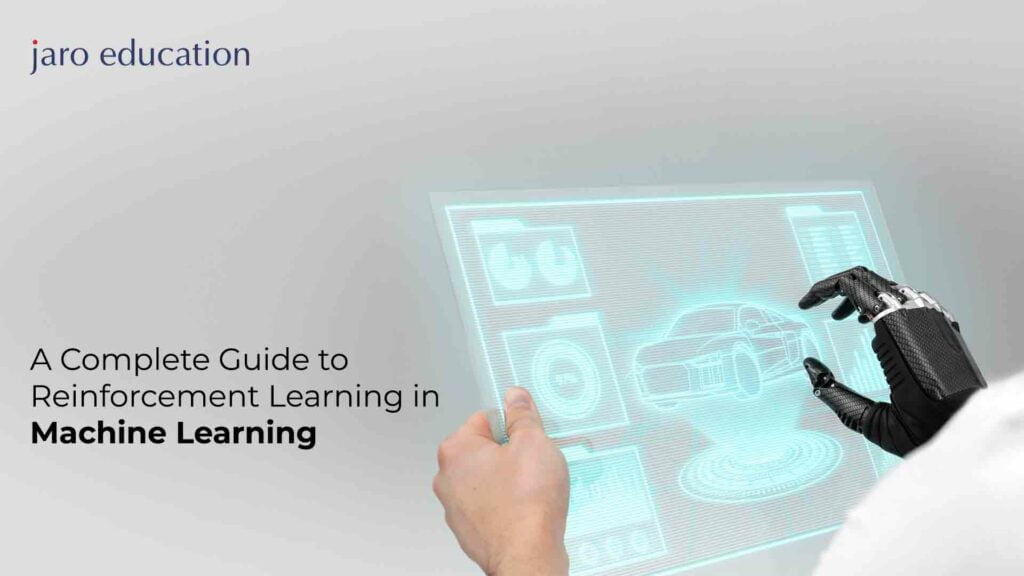Machine Learning has been adopted by almost every industry; reinforcement learning is there to make the best use of it. In simple words, reinforcement learning is all about action, rewards, and observations to train machine learning.
Reinforcement Learning (RL) is a machine learning algorithm that is probably between supervised and unsupervised. However, it cannot be classified solely on the set of labeled training data, but it is also not unsupervised learning because reinforcement learning agent helps to optimize a reward.
The learner must choose the right actions to take in numerous scenarios to acquire its primary goal. In this blog, we will understand the meaning of reinforcement learning, and different factors in reinforcement learning in machine learning.
What is Reinforcement Learning?
In Reinforcement Learning, an agent learns through making mistakes how to make choices that result in the best results through making mistakes. The agent interacts with the environment and learns from its interactions by being rewarded or punished. The agent makes use of this feedback to discover a policy that optimises its long-term cumulative reward.
Applications like driverless vehicles, recommendation systems, and financial trading have demonstrated this strategy’s effectiveness.
Importance of Reinforcement Learning
Machine learning has a subfield called reinforcement learning, which aims to train agents to learn by interacting with their environment and getting rewards or penalties for their behaviour. Developing intelligent systems that can learn from their experiences, make judgments, and conduct actions to accomplish particular goals is a potent strategy.
Here are some reasons why you need reinforcement learning to achieve your goal:
It allows for learning in challenging environments:
For challenges where the environment is complicated, dynamic, and challenging to model, reinforcement learning is a good solution. It enables agents to learn from mistakes and adjust to environmental changes.
It is appropriate for issues involving delayed rewards:
Delay in rewards is a common theme in real-world issues when the effects of a decision could not be seen for a while. By adopting a long-term perspective and learning to maximise cumulative rewards, reinforcement learning is able to deal with these issues.
It can adopt from diverse data:
Reinforcement learning is capable of learning from a variety of data sources, including simulations, in-person interactions, and specialised expertise. Due to its adaptability, it may be used for a variety of purposes, from robotics and games to banking and healthcare.
It can be used for continuous learning:
Reinforcement learning is a technique that allows agents to get better at what they do over time by picking up new skills. This may contribute to the development of more intelligent and adaptable systems that are capable of ongoing development.
Value Functions of Reinforcement Learning
Reinforcement learning, a sort of machine learning used to educate an agent on how to make decisions in an environment, is a key notion in value functions. Value functions are used to calculate the worth of being in a specific condition or doing a specific action, assisting the agent in making choices that will produce the best long-term results.
State-value functions and action-value functions are the two categories of value functions. While action-value functions calculate the value of performing a specific action in a specific state, state-value functions calculate the value of being in a specific state.
Finding the values of these functions for all potential states and actions, then picking the one with the highest value, yields the best course of action. Finding the best potential policy for the agent is done through a method known as value iteration.
In simple words, value functions are a potent tool in reinforcement learning that aids agents in learning how to respond best in complex settings and make informed judgments.
What is Deep Reinforcement Learning and Why to Use it?
An agent can learn through erroneous interactions with the environment using deep reinforcement learning (DRL), a kind of machine learning that blends deep neural networks and reinforcement learning. In DRL, the objective is to learn a policy that maximises the predicted cumulative reward over time. The agent receives a reward signal for actions that result in desired outcomes.
The Deep Q-Network (DQN), a well-liked DRL technique, makes use of a deep neural network to approximate the Q-value function, which stands for the predicted cumulative reward for performing a specific action in a specific state. The DQN technique employs a target network to stabilise the learning process and experience replay to sample previous experiences and learn from them.
Proximal Policy Optimization (PPO), a well-liked DRL technique, uses a gradient ascent method to optimise the policy function directly. Robotics, video games, and natural language processing are just a few of the tasks in which PPO has demonstrated excellent performance. PPO employs a trimmed surrogate target for steady learning and to avoid major policy modifications.
DRL has accomplished complex tasks that were previously thought to be insurmountable, such as playing machine games and becoming an expert at the game of Go, with astonishing success. DRL has also been used to solve practical issues, such as regulating autonomous vehicles and reducing building energy use.
Final Words
To sum up, reinforcement learning is a potent machine learning technique that allows an agent to learn from mistakes and experiences. It has uses in a variety of industries, including resource management, gaming, and robotics. To explore more, enroll in a data science course from IIT Madras.




